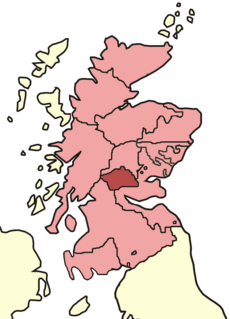
The Archdiocese of Saint Andrews & Edinburgh is an archdiocese of the Latin Church of the Roman Catholic Church in Scotland. It is the Metropolitan see of the Province of Saint Andrews and Edinburgh, consisting of the additional suffragan sees of Aberdeen, Argyll and the Isles, Dunkeld, and Galloway. The archdiocese is led by Archbishop Leo Cushley.
David Chillingworth is an Anglican bishop. He was Bishop of St Andrews, Dunkeld and Dunblane between 2004 and 2017, until his retirement. He was also the Primus of the Scottish Episcopal Church from 2009 to 2016.

The Diocese of Dunkeld was one of the 13 historical dioceses of Scotland preceding the abolition of Episcopacy in 1689.

The Bishop of Dunblane or Bishop of Strathearn was the ecclesiastical head of the Diocese of Dunblane or Strathearn, one of medieval Scotland's thirteen bishoprics. It was based at Dunblane Cathedral, now a parish church of the Church of Scotland. The bishopric itself certainly derives from an older Gaelic Christian community. According to legend, the Christian community of Dunblane was derived from the mission of St. Bláán, a saint originally associated with the monastery of Cenn Garath (Kingarth) on the Isle of Bute. Although the bishopric had its origins in the 1150s or before, the cathedral was not built nor was the seat (cathedra) of the diocese fixed at Dunblane until the episcopate of Clement.

The Diocese of St Andrews, Dunkeld and Dunblane is one of the seven dioceses of the Scottish Episcopal Church. It is centred on St Ninian's Cathedral in Perth, and covers Fife, Perthshire, Kinross-shire, Clackmannanshire, and eastern and central Stirlingshire. The current Bishop of St Andrews, Dunkeld and Dunblane is the Ian Paton.
The Bishop of Glasgow and Galloway is the ordinary of the Scottish Episcopal Church Diocese of Glasgow and Galloway.
The Bishop of St Andrews, Dunkeld and Dunblane is the Ordinary of the Scottish Episcopal Diocese of St Andrews, Dunkeld and Dunblane. The see is located at St Ninian's Cathedral in Perth, Scotland.

The Diocese of Dunblane or Diocese of Strathearn was one of the thirteen historical dioceses of Scotland, before the abolition of episcopacy in the Scottish Church in 1689.

St Mary's Episcopal Church is a medium-sized church of the Scottish Episcopal Church in Dunblane, Scotland. It is situated by the Fourways roundabout.

Henry de Lichton [de Lychtone, Leighton] was a medieval Scottish prelate and diplomat, who, serving as Bishop of Moray (1414–1422) and Bishop of Aberdeen (1422–1440), became a significant patron of the church, a cathedral builder, and a writer. He also served King James I of Scotland as a diplomat in England, France, and Italy.
Dúghall of Lorne [or de Ergadia] was a late 14th century and early 15th century prelate in the Kingdom of Scotland. Probably a MacDúghaill (MacDougall) from the province of Lorne in Argyll, he appears to have studied at the University of Oxford before returning to Scotland for an ecclesiastical and administrative career. He obtained benefices in the diocese of Argyll, Dunkeld, Dunblane and St Andrews, and acted as the secretary and chaplain of Robert Stewart, Earl of Fife, before becoming Bishop of Dunblane. He held the bishopric of Dunblane until his death in 1403.

Piers Holt Wilson was an Anglican bishop in the mid part of the 20th century.

James Lumsden Barkway was a bishop in the 20th century.

Edward Thomas Scott Reid was a Scottish Anglican bishop who ministered in the Scottish Episcopal Church.
Michael Harry George Henley, CB was an Anglican bishop. He was a chaplain of the Royal Navy and the Bishop of St Andrews, Dunkeld and Dunblane.
Patrick Torry (1763–1852) was a Scottish Anglican bishop who served as a bishop in the Scottish Episcopal Church during the first half of the 19th century.
Charles Rose was an Episcopalian clergyman who served in the Scottish Episcopal Church as the Bishop of Dunblane (1774–1791) and Bishop of Dunkeld (1776–1786).
Kenneth William (Kenny) Rathband is the former Dean of St Andrews, Dunkeld and Dunblane in the Scottish Episcopal Church.
John Torrey was a Scottish Episcopalian priest who served as Dean of St Andrews, Dunkeld and Dunblane.
Ian James Paton is a British Anglican bishop. Since 2018, he has been the Bishop of St Andrews, Dunkeld and Dunblane in the Scottish Episcopal Church.
This page is based on this
Wikipedia article Text is available under the
CC BY-SA 4.0 license; additional terms may apply.
Images, videos and audio are available under their respective licenses.









